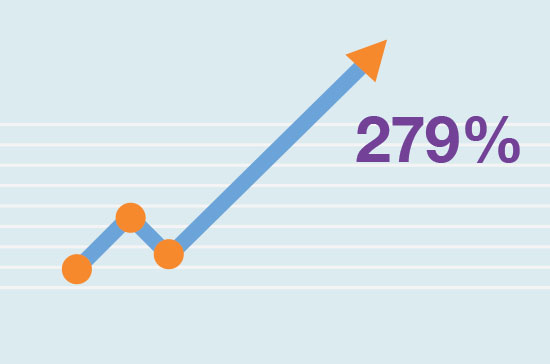In this article...
- Organizations can take a tactical and iterative approach to applying cognitive solutions for marketing and sales
- Even pilots and starter projects need to connect to the organization’s nervous system to be fully functional and to yield optimal results
- Value comes from new ways to understand and extract insights from a combination of data types and sources
Cognitive computing and artificial intelligence (AI) have attracted much attention lately with their promise of futuristic advances, but in a real sense these technologies are already becoming integral to marketing and sales operations. Our research shows that marketing and sales are a top priority for cognitive decision makers, with 64 percent of advanced users already applying cognitive in this area.
An essential attribute of a cognitive solution is the ability to probe vast amounts of under-utilized data to find actionable insights. While that may seem like the goal of advanced analytics already in the market, cognitive solutions can add intelligence to data by reasoning, predicting and providing recommendations—a key differentiator for marketing and sales optimization.
How are organizations using cognitive technology to optimize marketing and sales? They’re using it to keep up with the growing volume and velocity of data critical to targeting their audiences. Cognitive solutions help them speed up discovery and synthesis of information and then help augment decision making to reach, engage and maintain valuable customer relationships. These cognitive-enabled marketing and sales applications are delivered in everything from chat bots and virtual assistants to market segmentation and content optimization and recommendation systems.
Starting one pilot at a time
Getting started on cognitive business initiatives can seem just as daunting as trying to figure out how to capitalize on any other massive technology shift. But early adopters say it doesn’t have to be overwhelming and it doesn’t have to be directed by a long-term strategy. Every company’s journey is unique—varying by company size, data strategy, products and services used. Cognitive adoption can be organic and evolve as companies experiment and start seeing benefits from their initial efforts.
While cognitive projects can have a transformational goal—looking across the enterprise and across broad business needs—many companies take a more focused, tactical approach.
Pon Holdings is a Dutch transportation conglomerate with 70 subsidiaries specializing in commercial and consumer automotive equipment. Pon takes a centralized approach to business intelligence, serving all its companies through an incubator that vets and provides the latest capabilities to any of its companies that need it. While the company had access to a lot of data, it wanted to better understand its market share and ensure that all potential sales opportunities were being targeted.
Even with advanced analytics already in place, Pon selected its division that includes Caterpillar equipment as a prime candidate to roll out a cognitive solution to improve lead generation. By mining unstructured web data for product pricing, equipment purchase records and market trends, Pon was able to gather solid lead prospects and also fine-tune pricing to optimize revenue. Based on the success of the first cognitive application, Pon is now rolling out additional marketing use cases across its other companies.
The cognitive solution used by Pon was implemented by Jibes Software. Paul Van Der Hulst, Founder & Director at Jibes, stresses that while companies frequently start with a single cognitive product for a particular use case, the cognitive project still needs to be integrated with company-wide data, processes, and systems to be effective. According to Hulst, even a pilot for a specific business need like lead generation has to be connected to the organization’s nervous system to be fully functional and to yield optimal results. In this case, it may connect to customer relationship management systems, marketing dashboards, procurement and supply chain management processes. Integrating pilots and starter engagements also makes the next cognitive application or phase more seamless.
“A lot of companies are over analyzing what they should be doing. And that means that they want to exclude all risk. It doesn’t work that way. Better to start small with a good idea and from there scale out and scale up. There is no universal template for success, but focus and persistence are a proven formula,” said Hulst.
In additional to impacting the bottom line with leads and revenue, driving customer acquisition through cognitive insights has also changed the strategic conversation at Pon Holdings because of the visibility and intelligence that marketing and sales teams now have about their prospects and customers. Hulst explained, “There’s a better and fact-based strategic dialogue about customers. It’s more event driven and we are able to make better informed decisions. It’s really a 180 degrees reversed sales approach, focused on monitoring the market and acting on classified events rather than taking a historical view or assumptions and extrapolation.”
“ A lot of companies are over analyzing what they should be doing. And that means that they want to exclude all risk. It doesn’t work that way. Better to start small with a good idea and from there scale out and scale up. ”
- Paul Van Der Hulst, Founder & Director, Jibes
The business-to-business advantage
Generally speaking, there are two common approaches to applying cognitive for marketing and sales goals. Many organizations start with capabilities such as natural language processing (NLP), pattern recognition or machine learning to mine new data or tackle it differently for insights they can use in their own organizations. But increasingly, companies are also looking to embed cognitive into broader solution sets that they can offer to their own customers—cognitive insights about the market or customer behavior, preferences and buying patterns directly at their fingertips without having to deal with the underlying cognition processes.
Influential, a Las Vegas-based company that helps organizations expand their reach through influencer marketing, looked to cognitive solutions as a way to enhance their influencer dashboard by adding cognitive personality insights into their solution. Ryan Detert, CEO, Influential said, “How do we best provide back real time as well as post-mortem data on a campaign? We made it extremely simple and that is key to tell clients a story they understand and then show them a product that looks and feels very intuitive.”
Cognitive APIs were integrated into the dashboard, pulling in and analyzing unstructured data from social channels including Twitter, YouTube, Instagram and Firehose. This in turn allowed Influential to work with their customers to select a variety of attributes in order to understand people's personality characteristics, needs, and values to then drive personalization in influencer-based campaigns such as the Kia Optima Super Bowl promotion. Influencers were selected to share insights through social channels to reach new audiences to raise awareness and excitement about the Optima car.
According to Detert, “The ultimate idea is word of mouth at scale. To generate earned media on their content and messaging is why brands are on social media. To be able to start that snowball down the hill. The Ice Bucket challenge type effect.” By finding the right set of influencers, paired with the most authentic message from that influencer to their target social followers, Influential was able to over-deliver on the campaign goals by 279 percent. More than 90 percent of consumers who engaged with influencers using the campaign’s hashtag shared cognitive personality insights that Kia selected upfront to identify their core consumer.

Influential was able to over-deliver on the campaign goals by 279 percent. More than 90 percent of consumers who engaged with influencers using the campaign’s hashtag shared cognitive personality insights.
Influential was able to over-deliver on the campaign goals by 279 percent. More than 90 percent of consumers who engaged with influencers using the campaign’s hashtag shared cognitive personality insights.
The business value of data
While it’s ultimately geared to tap new or under-utilized data, the use of cognitive technology doesn’t mean that organizations have to mine unstructured data to find value. Value comes from new ways to understand and extract insights from any data whether it’s structured or unstructured. In their recent projects, both Influential and Pon Holdings focused heavily on mining unstructured data from public sources including websites and social media. On the other hand, companies like New-York based RSG Media are finding great value in applying cognitive to uncover new insights from primarily structured data.
RSG Media infuses intelligence into how media and entertainment companies understand viewership patterns to ensure that their programming and advertising target the right audience at the right time. As Shiv Shegal, Lead Architect at RSG Media explained, true value can come from reexamining existing data through a cognitive lens. Leveraging cognitive products, APIs and developing their own artificial intelligence algorithms, RSG Media helps clients maximize use of their content inventories. Now they have deeper insights about viewership patterns in structured data including Neilson, Netflix and Hulu data. These insights help RSG Media’s customers decide what content to broadcast, when to run programming and when to place advertising to reach and keep audiences engaged and responsive.
Shegal explained, “Our data is the marriage between first and third-party data sets. Third-party data is data sets that anybody can buy. But the first party data is kind of data with cookie level information. The ability to tie respondent level data to third-party data, that’s the golden goose to tackle a lot of problems.”
While large-scale transformational projects need extensive training to build a corpus of knowledge for the cognition process to be effective—usually requiring several months—the majority of off-the-shelf cognitive applications can be trained in a few weeks with the help of domain experts who understand the use case and can help build the knowledge-base to run the application. On the other end of the spectrum, many cognitive APIs are virtually plug and play, either pre-trained or requiring minimal training so they can ingest documents and information quickly and be ready for the cognitive task at hand in just minutes.
“Just getting access to this information is hard. We’re taking into account mountains and mountains of data across all these different platforms. Being able to build audiences while grabbing and holding competitor audiences, that’s where the cognitive piece comes into play. By forecasting where eyeballs are at and where they’re going, we can actually provide nudges to schedulers, ad sales and marketers, to reach those viewers,” said Shegal.
“ Just getting access to this information is hard. Being able to build audiences while grabbing and holding competitor audiences, that’s where the cognitive piece comes into play. ”
- Shiv Shegal, Lead Architect, RSG Media
Engaging the new network of players
Increasingly there is a blend of roles influencing technology requirements and purchases, and this is clear in cognitive engagements as well. Improving customer acquisition might have typically been the domain of sales and marketing teams but organizations are now approaching both the problem and solution from various vantage points.
These divergent approaches are striking. The CEO of Influential, Ryan Detert, is involved in working with clients as well as evaluating the right cognitive solutions, a job he does with the CTO and input from the data team. At Pon Holdings, however, the centralized model of managing business intelligence means that the BI team frequently engages with the marketing and sales teams to figure out how cognitive and analytics can drive their lead generation goals. And at RSG Media, as the Chief Architect, Shiv Shegal collaborates with a team of technical and business experts to test out new tools and he continually pulls in feedback from client teams.
Working teams have changed, too. More people are now involved, including employees from lines of business, IT, research and a whole crop of data professionals including analysts and scientists. Companies have also gone from traditional interactions with sales representatives to wanting to test-drive cognitive capabilities themselves—an inventive and organic approach to enhancing solutions with a cognitive edge.
What is clear from these companies’ experiences is that cognitive capabilities are no longer a futuristic aspiration. Cognitive is quickly finding a place, not only in marketing and sales organizations, but also at all levels of the business with the promise to find and engage new customers.
Share this page
Want to learn more?




